



Martha Schwendener at the New York Times takes a less jaundiced and judgmental view of Brion Gysin's life and work than did Artnet's Ben Davis. Her concluding paragraph:
The audience for magic was small during Gysin’s lifetime. But young artists skeptical of scientific rationalism — or whatever brand of theory they’ve been offered at art school — are finding Gysin’s approach alluring. Which is why, in a bout of art historical conjuration, his reputation as an “unsuccessful artist” is being overturned.
As a refudiation (thank you, Sarah Palin!) of Ben Davis's smug materialism this appeals but as noted earlier, Gysin "is not in need of debunking any more than he is in need of posthumous inflation." It doesn't matter whether the artists interested in Gysin are "young" or not, they only need be younger than Gysin (that is, alive) for his continuing influence to be noted.
The rather handsome photo of Brion Gysin's Dreamachine installation (as installed at the New Museum) by Naho Kabuta deserves a reality check in the form of this photo from the Internet of an earlier incarnation (in Bristol, England):

The New Museum tends to confer instant fabulousness on everything inside it but let's remember that the Dreamachine is something you experienced with eyes closed, so you could put it on top of an old tablecloth and it would still take you higher.
More coming on what some of what those younger-than-Gysin artists are doing with his imagery floating around the Net.
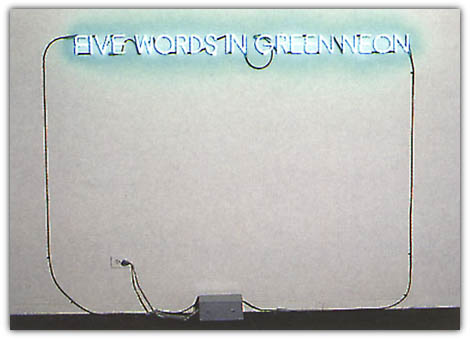
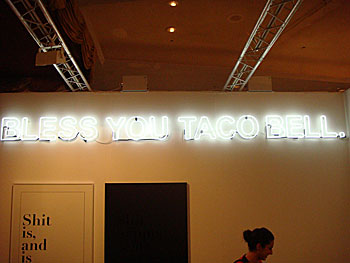
...from linguistics to identity politics to a simple "fuck you" in 45 years. (Top to bottom: Joseph Kosuth, Glenn Ligon, Michael Phelan) (hat tip Jesse for the first two)
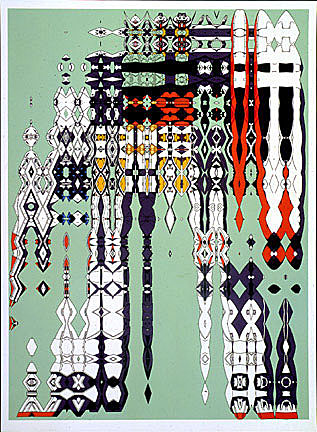
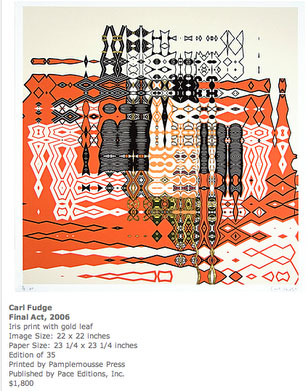
In his review of the New Museum's Brion Gysin exhibit, Artnet critic Ben Davis begrudgingly acknowledges that Gysin has influenced some contemporary artists. But then he works himself into a snit because the museum claims that Gysin isn't just an inspiration but a role model for artists. Attacking the hype is always kind of a greasy strategy when the work is right in front of you. Seizing on the phrase "role model" allows Davis to downplay discussion of what's on display in favor of a lengthy stroll through the artist's life, which Davis finds unsavory for rather priggish-sounding moral reasons, considering that we're talking about a figure who straddled surrealism and the Beats. Davis scolds Gysin in the grave for being overly fond of boys, admiring black people, and showing insufficient commitment to smashing the fascist state in the name of international socialism.
Davis mentions that Gysin's cut-up technique was employed in three William Burroughs books but neglects to mention that they are Burroughs' most important: Naked Lunch, Soft Machine, and The Ticket That Exploded. Pursuing his thesis that Gysin is a lousy role model because his artistic rationales have become quaint, Davis has a good laugh at some ideas of Gysin and/or Burroughs:
--that the "Cut-Up Method" could "free human creativity from what he and Burroughs both called 'Control'-- the soulless rationality of the modern world, the evil specter of normalcy that they saw as their enemy."
--"the Surrealist fascination with madness and altered states of all kinds, and, most problematically, the belief that one could find in an exoticized Primitivism an antidote to suffocating Western middle-class life."
--"the underlying... notion that living a free-spirited bohemian lifestyle is in itself an unthinkable rebellion against the entire system."
Davis presumes to speak for artists in suggesting that none of these motivations matter now. Most don't sound so bad to me, even as snidely phrased by Davis. Davis assumes all artists have reached the same conclusions he has in other writings: that the endless contradictions of reconciling Marxist thought and a market-driven economy have beached everyone in the art world on the same shoals of boredom, paralysis, and repetition of post-post-postmodern ideas.
Well, I have no idea if painter Carl Fudge, whose work is depicted above, considers Brion Gysin a role model but he seems taken enough with the cut-up method to have made a small career out of it, and even made it, dare I say, exciting. Any artist who is using a gridded system to break apart, re-connect, and defamiliarize an image is a Gysin heir, whether the means be scissors and tape or photoshop and jape. There are many of them and my guess is that on some level most of them see art as a valid alternative to the soulless rationality of the modern world.
After my post yesterday bemoaning Davis's dismissive review, Duncan Alexander, aka Hypothete, made some digital cutups of Gysin's cutups that rev the work up to Internet speed. These animated GIFs fuse the strobo-kinesis of the Dream Machine with the slice and dice of the still imagery. Whether the result is a mystical experience or just a seizure is left to the viewer. One complex and seductive take on Gysin filmstrips seems dangerously free-spirited and I hope Davis doesn't find out that artists are doing such things now. It's much more important that we all be whining about "the market" and moaning that there's nothing left to do.
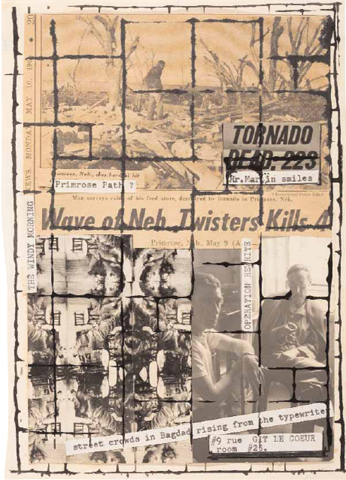
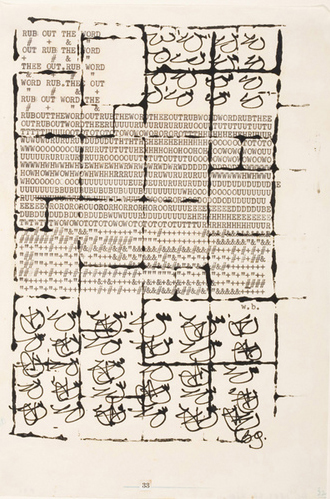
Dear reader, I would like to ask you a favor. Can you please repost one or both images above on your social media vehicle of choice? They are collaborative artworks by Brion Gysin and William Burroughs, published on the occasion of a Gysin exhibit currently on view at the New Museum in NYC. Marxist scold critic Ben Davis believes these images belong to a vanished world--and I don't agree. (cf. Sigmar Polke, Nasty Nets, Photoshop, newmoticons, jimpunk, etc.) If you don't either, could you please help me circulate them via that most un-vanished of media, the Internet? Thanks.
As I've noted at Paddy's, solo Gysin may not be as influential as Gysin/Burroughs but the man is not in need of debunking any more than he is in need of posthumous inflation. Davis's critical method consists of a prolonged character assassination of Gysin the person, judging him by standards of political correctness that didn't exist in Gysin's day. And a few incidental descriptions of artworks, which should have been the meat of the review, since that's what's on display.
More on the vanished world--Davis somehow maintains that while Gysin's images, maybe, possibly, could be influential today, the thinking behind them is not.
Update: Corrected post to note that above images are Gysin/Burroughs, not Gysin solo.